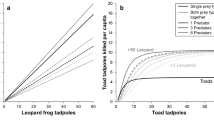Summary
Laboratory feeding trials were conducted with the predaceous stonefly Hesperoperla pacifica and a number of mayfly and dipteran prey species to investigate the effects of predator size, and prey size and morphology, on the predator's success. Observations under dim red light permitted estimation of encounter rate (E/min), attack propensity (A/E), capture success (C/A) and handling time (HT). For prey of a particular species and size, HT decreased log-linearly with increasing predator size. Across all prey categories, HT increased log-linearly with increasing values of the ratio prey dry wt/predator dry wt, and differences among species appeared to be small. Overall, capture success was low, but C/A was higher for dipterans than for mayflies, especially with large H. pacifica. Predator size affected C/A when prey fell within a certain size range, but was not a detectable influence with very small or very large prey. Values of A/E of near 10% typified many predatorprey combinations; however, ephemerellid mayflies suffered markedly fewer attacks, and values of A/E up to 30% were obtained with some species-size combinations. We estimated benefit to the predator first as prey wt ingested per unit time (dry wt/HT), and second by mutliplying the former term by capture success. Values increased with increasing size of the predator, and inclusion of the C/A term indicated that predators would obtain greater reward from small relative to large prey, and from dipterans relative to mayflies. Howerver, there was little evidence that attacks were biased toward more profitable prey. We compare the relative contributions of E/min, A/E and C/A to prey choice, and discuss their applicability to predation events in nature.
Similar content being viewed by others
References
Allan JD (1982) Feeding habits and prey consumption of three setipalpian stoneflies (Plecoptera) in a mountain stream. Ecology 63:26–34
Allan JD, Flecker AS, McClintock NL (1987a) Prey size selection by carnivorous stoneflies. Limnol Oceanogr 32:864–872
Allan JD, Flecker AS, McClintock NL (1987b) Prey preference of stoneflies: factors affecting prey vulnerability. Oikos 49:323–331
Cooper SD, Smith DW, Bence JR (1985) Prey selection by freshwater predators with different foraging strategies. Can J Fish Aquat Sci 42:1720–1732
Cummins KW, Wuycheck JC (1971) Caloric equivalents for investigations of ecological energetics. Mitt. int. Ver. Limnol. No 18, p 158
Gerritsen J, Strickler JR (1977) Encounter probabilities and community structure in zooplankton: a mathematical model. J Fish Res Bd Can 34:73–82
Giguere LA, Delage A, Dill LM, Gerritsen J (1982) Predicting encounter rates for zooplankton: a model assuming a cylendrical encounter field. Can J Fish Aquat Sci 39:237–242
Greene CH (1983) Selective predation in freshwater plankton communities. Int Revue ges Hydrobiol 68:297–315
Malmqvist B, Sjöström P (1980) Prey size and feeding patterns in Dinocras cephalotes (Perlidae). Oikos 35:311–316
Molles MC Jr, Pietruszka RD (1983) Mechanism of prey selection by predaceous stoneflies: roles of prey morphology, behavior and predator hunger. Oecologia 57:25–31
Pastorak RA (1981) Prey vulnerability and size selection by Chaoborus larvae. Ecology 62:1311–1324
Peckarsky BL (1980) Predator-prey interactions between stoneflies and mayflies: behavioral observations. Ecology 61:932–943
Peckarsky BL (1984) Predator-prey interactions among aquatic insects. In: Resh VH, Rosenberg DM (eds) The Ecology of Aquatic Insects, Praeger Scientific, pp 196–254
Peckarsky BL (1985) Do predaceous stoneflies and siltation affect the structure of stream insect communities colonizing enclosures? Can J Zool 63:1519–1530
Peckarsky BL, Penton MA (1988) Mechanisms of prey selection by stream-dwelling stoneflies
Reissen HP, O'Brien WJ, Loveless B (1984) An analysis of the components of Chaoborus predation on zooplankton and the calculation of relative prey vulnerabilities. Ecology 65:514–522
Scott MA, Murdoch WW (1983) Selective predation by the backswimmer, Notenecta. Limnol Oceanogr 28:352–366
Sheldon AL (1969) Size relationships of Acroneuria californica (Perlidae, Plecoptera) and its prey. Hydrobiol 34:85–94
Sjöström P (1983) Prey consumption by nymphs of Dinocras cephalotes (Plecoptera). PhD diss, Univ Lund
Sjöström P (1985) Hunting behavior of the perlid stonefly nymph Dinocras cephalotes (Plecoptera) under different light conditions. Anim Behav 33:534–540
Walde SJ, Davies RW (1984) Invertebrate predation and lotic prey communities: evluation of in situ enclosure/exclosure experiments. Ecology 65:1206–1213
Winterbourn MJ (1974) The life histories, trophic relations and production of Stenoperla prasina (Plecoptera) and Deleatidium sp. (Ephemeroptera) in a New Zealand stream. Freshw Biol 4:507–524
Author information
Authors and Affiliations
Rights and permissions
About this article
Cite this article
Allan, J.D., Flecker, A.S. Prey preference in stoneflies: a comparative analysis of prey vulnerability. Oecologia 76, 496–503 (1988). https://doi.org/10.1007/BF00397860
Received:
Issue Date:
DOI: https://doi.org/10.1007/BF00397860




